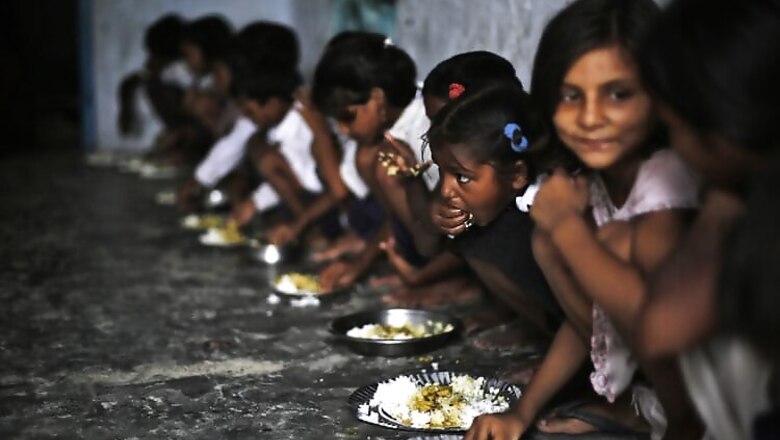
views
Midday Meal is a unique concept materialized to improve the nutritional state of school age children. The impact of the program is multifold and diversified. Midday Meal scheme is imperative to substantiate the initiative of government to effectively impact at the nutritional aspect of the country along with education. In a country such as India, where poverty is chronic, for upbringing of the masses several socio-economic aspects need to be worked upon all at the same time. By targeting schoolchildren, the program is administering a substantial thrust to capacitate the upcoming generation of the nation keeping in close ties with social and economic issues.
Although the concept remains the same, the process of implementation went through series of structural and functional changes to reach the present state it is today. Allocation of funds, subsidy rates, costs of implantation are through timely amendments. The organization structure of the program is well designed for effectively and optimal implementation with multiple supervising authorities. However, the success of the program is backlogged at the end levels of its deployment.
The success of Midday Meal is dependent on three basic parameters: Allocation of funds, Implementation Structure at Root Level, and organization of the stakeholders involved. The government will have to reform these three aspects of the program for optimal effect. A minute glitch in deployment of the service coalesces as serious threats of health and hygiene of children. As serious lapse at implementation levels of the program is pertinent, the necessary changes must be substantiated by authorities to prevent misuse and wastage of resources. More emphasis should be on allocation of fund, as the other two will be eventually shaped up by the former.
The issue with allocated of fund is its monotonous aspect. The central government has allocated a fixed sum with a very little variation for the whole nation, that too, for almost an undefined time. However, prices of food commodities are highly flexible being subjected to availability of stock in the market. For this, providers have to procure items at more prices than the allocated amount. Most of the times, the easier way is chosen, procuring low cost items that directly affects the quality of food. It does not have adverse effect on children, but the level of nutrition they receive is certainly not at par with the prescribed norms. To address this issue, allocation of larger fund is not required, but the government should be more intuitive and insightful on the amount. The authority should maintain a flexible structure of fund, which is scalable throughout both time and geographic locations. The need is not to invest more, but to have more control and subjective authority on allocation. This can be attained by maintaining an independent but liable authority to monitor funds in the scheme.
The present scheme lacks an effective method of evaluation of the cost involved. Products, raw materials and expense heads involved in Midday Meal Scheme needs to be measured by their worth. Moreover, procurement and storage are largely dependent on geographical locations. For instance, in hot areas, raw materials are more likely to rot in short time. Hence, for such locations, there should be either enough provisions for cold storage at district level or provisions to manage an on demand and quick supply chain management.
The centralized kitchen model of implementation, undertaken through Public Private Partnership has been effective to deliver quality in Midday Meal programs throughout urban locales. However, in this system too, stakeholders are enduring tough times. Private entities are subjected to laws entitled to corporations and are liable to every tax. The approach of the government was towards involving these entities in the system to leverage the competitive aspect of their service in the run to attain profit from the scheme, but under the current system, Midday Meal Scheme is run more as a charitable organ with little or no profit.
Centralized kitchens are allocated Rs. 3.59 per day per meal. Within this amount, they have to manage a high food quality, expenses for modern technology, storage, transportation, labor cost, and taxes. Apart from these direct costs, an array of expense as VAT on consumables and machinery, Excise duty, Road Tax and others centralized taxes are subjected on service providers. Being liable to state and central taxes, centralized kitchens are left strayed on the marginal side of the business without any earnings. On the other hand, most of these entities such as, Annamrita and other such organizations are more into charity rather than business. Hence, it is advisable that government should make provisions for centralized kitchens at the least, to waive the array of direct and indirect taxes involved in the operation chain.
Today, Midday Meal program is supporting more than 12 million children across India, running throughout 1,265,000 Schools and Education centers. As it involves raw material, cooking and storage of decomposable products, maintenance of the program at physical levels is quite tough in practice. In fact, a pragmatic way for successful implementation of the scheme for its optimal effect is yet to materialize. The initiatives of the government should be directed towards leveraging the potential of the system moving on tandem with the current market scenario and the industry.
(Author Sanjay Tikku is Director, ISKCON Food Relief Foundation)



















Comments
0 comment